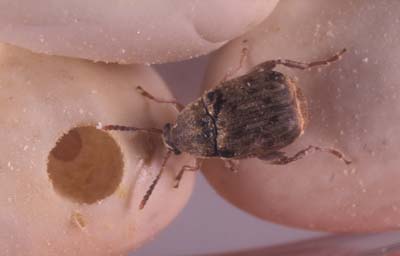
Adult bean weevil, Acanthoscelides obtectus, near adult exit
hole.
(Photographer: L.J. Buss, University of Florida)
The bean weevil is an important pest of stored legumes and certain other seeds, infesting them both in the field and in storage. The adults do not feed on legume seeds. This species occurs throughout the U.S. Despite its name, it is not a true weevil.
The adults are olive brown mottled with dark-brown and gray. They are about 2 to 3 mm in length. The adult beetle has one large and two small spines on the hind femur. The legs and antennae are reddish. The adult female lays an average of 75 eggs, singly or in clusters near beans or related seeds. Larvae live inside a bean, which may include several larvae, and leave round holes when they emerge as adults. The life cycle can be completed in 21 to 80 days.
Images
To save the Web-optimized images shown below to your hard drive:
|
Click to access Display and Print quality images. |
|
Click to access Display and Print quality images. |
|
Click to access Display and Print quality images. |